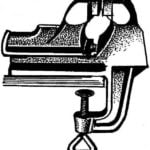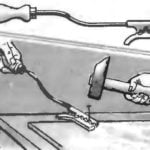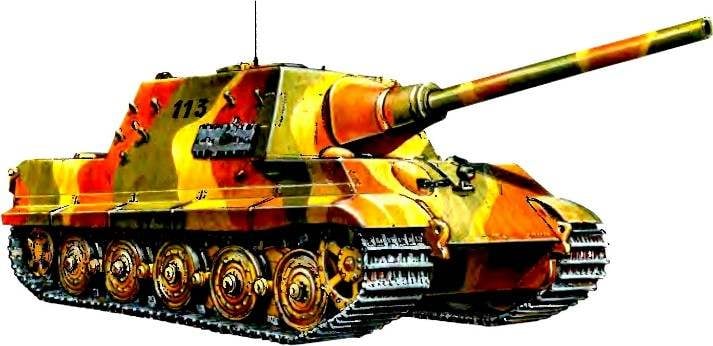
During the design of a heavy tank Tiger II Henschel firm in cooperation with the Krupp firm started to create a heavy assault gun based on it a New self-propelled gun was planned to equip 128-mm cannon, high-explosive shell which had a much greater explosive effect, than the 88-mm anti-aircraft gun FlaK 40 Wooden model of ACS in full size was demonstrated to Hitler on 20 October 1943 at the site of ARIS in East Prussia ACS made the Fuhrer the most favorable impression and was followed by “higher” the order to begin its serial production in the following year, on 7 April 1944 the car was named Panzerjager Tiger Ausf V (Sd Kfz 186), later simplified to the Jagdtiger After 13 days produced in the metal of the first sample At full combat weight of 75.2 t ACS was the most difficult of all involved in the Second world war military vehicles.
The overall layout of the engine-transmission group and chassis self-propelled units remained the same as in the tank “king tiger” However, the load on the chassis when fired, was supposed more than the tank, so it lengthened to 260 mm.
The hull of the tank has undergone almost no changes in either the part design or part of the thickness of the armor side of the wheelhouse were the one with the hull sides and had the same thickness of 80 mm. head and stern sheets of felling connected with sides “a thorn”, was strengthened with dowels, and then obvalivanie the thickness of the frontal sheet cutting reached 250 mm, it was located at an angle of 75° to the horizontal, making it practically invulnerable for all antitank means of the enemy at a distance over 400 metres of the rear sheet had a thickness of 80 mm. it was a hatch for Dismounting guns, load ammunition and evacuation of the crew, skryvavsheysya double lid hinged Roof cuttings were made of 40-mm bronelista and attached to the body bolts In the right front of the roof of the deckhouse housed the commander rotating observation tower with a viewing device, covered with a U-shaped armored shackle in Front of the device in the roof of the turret had a hatch for installing the telescope For the commander’s cupola housed the boarding hatch of the commander, and left her — loophole periscope sight the gun in addition, in the casemate roof mounted fan, “device melee” and the four surveillance device.
In the embrasure of the front sheet of the pilothouse, covered with a massive cast mask, sets the gun 12,8 cm Pak 44 (80 Cancer) caliber 128 mm Initial velocity armor-piercing projectile reaches 920 m/s Length of the gun barrel, developed by Krupp and manufactured at the company Bertha-Werke in Breslau, was 55 calibers (7020 mm) Weight guns — 7000 kg the Shutter — wedge, horizontal, had a 1/4 automatics, that is, opening the breech and ekstragirovanie the casings was done manually and after the chambering of the projectile and charge the shutter to close automatically after the Gun was mounted on a special machine installed in the housing SPG Vertical guidance was carried out in the range from -7° to +15°, horizontal 10° to the side of the Wheel the device was located on the gun barrel Limits the length of the rollback — 900 mm max firing range high-explosive projectile reaches 12.5 km.
Gun Cancer 44 differed from the 128-mm anti-aircraft gun Flak 40 dual core loading In a cramped cabin ACS with a cumbersome and heavy “unitary” it was not possible to turn. To speed up the process of loading the crew “Jagdtiger” consisted of two charging while one runaway to the chamber shell, the other was filed a cartridge case with the charge nevertheless rate “Jagdtiger” does not exceed 2 — 3 RDS/min.
Ammunition of the ACS was located on the floor of the fighting compartment and the sides of cuttings in homutikov the pilings and was 38 — 40 shots.
Periscope sight WZF 2/1 had a tenfold magnification and field of view 7°, allowing to hit targets at distances up to 4000 m.
It is interesting to note that the 128-mm gun Pak 44 first appeared at the front in August 1944 as a field anti-tank gun Because the gun carriage constructed for her, an oscillating part mounted on the carriage of captured Soviet 152-mm howitzer M-10 howitzer-guns ML-20 and the French 155-mm guns Total thus produced 116 guns.
Auxiliary armament “Jagdtiger” consisted of a MG 34 machine gun was placed in a ball mount in the hull Ammunition of the machine gun with 1500 rounds On the turret roof was installed “device melee” — martika to fire frag and smoke grenades.
“Jagdtiger” was set the same as on the tank “Royal tiger” 12-cylinder V-shaped gasoline four-stroke engine Maybach HL 230P30 700 HP at 3000 rpm (in practice the speed not exceed 2500) engine Dry weight was 1300 kg the fuel used is leaded petrol with octane number not below 74 the Capacity of the seven tanks reached 860 L.
Transmission of ACS consisted of a driveline, transmission with built-in main clutch, rotation mechanism, final drives and disc brakes thus the main clutch, gearbox and the rotation mechanism, consisting of two summing planetary gear sets, constructively were combined into a single unit — dual flow mechanism of transmission and rotation.
In General, the engine and transmission self-propelled guns were borrowed from the tank “king tiger” with minimal changes, for Example, there was no PTO for hydraulic drive of rotation of the tower, as its on the ACS was not.
Panzerjager Tiger Ausf.B.
The tank destroyer “Jagdtiger”:
1 — 128-mm gun; 2 gun mask, 3 — swab, 4 — towing cable; 5 — antenna, 6 — us exchange machine gun, 7 — lights with svetamaksimova nozzle, 8 — stern hatch, 9 — exhaust pipe 10 — the Jack 11 — Luke radioman, 12 — driver’s hatch, 13 — commander’s cupola, 14 — loophole periscope sight guns, 15 — recess devices “melee”; 16 — the boarding hatch of the commander, 17 — hole air flow units, 18 — hole vozdukhovody, 19 — reservation air-vents for air flow to the air filters.
The chassis was mostly the same tank and in relation to the same Board consisted of nine all-metal tandem rollers with internal depreciation, staggered in two rows (five rollers in the outer row, four in the interior) Dimensions of the rink 800×95 mm Suspension is individual, torsion, single-shaft Diameter of the torsion — 60. 63 mm Balancers front and rear rollers supplied with hydraulic shock absorbers placed inside the housing the drive wheels to the forward position had two removable ring gear and 18 teeth in each Engagement cycloid idler diameter 650 mm had metal tyres, and crank tensioning mechanisms caterpillars
Lengthening the body 260 mm resulted in an increase in the length of the supporting surface 4120 to 4240 mm. However, due to the increased mass of the ACS compared to the tank in the 5 t specific ground pressure, not only not decreased but increased from 1.02 to 1.06 kg/cm2.
Assembly of the chassis ACS “Jagdtiger” (as, indeed, and of the “Royal tiger”) was one of the most laborious operations seriously delayed the production process So the design office of Ferdinand Porsche, the initiative proposed to apply to “Jagdtiger” suspension, the same is installed on the tank destroyer “Ferdinand” Feature of this suspension was that the torsion bars were not located inside the case and outside, inside the truck, Each of such longitudinal torsion bars “worked” on two supporting roller. The gain in mass of the suspension was 2680 kg, and in the course of manufacturing and Assembly — 390 kg
In addition, the installation and tightening of the standard torsion bar suspension was possible only in the assembled housing, in strict order and using a special winch. Replacement of torsion bars and suspension beams could be made only at the factory the Assembly of the trucks suspension Porsche was possible separately from the body, and their installation could be carried out without the use of special equipment is Not difficult to repair and replacement of broken-down trucks suspension in the front line.
Suspension Porsche built two cars (only produced four sets of suspensions), the first of which was released for testing even earlier than the car with the suspension of the company Henschel. However, despite all the advantages of the chassis, designed by F. a Porsche, the Office of weapons’t recommend it in production. The main reason was more than a strained relationship between officials and the Builder. Played a role and the damage to the truck suspension during testing that occurred through the fault of the manufacturer However, you cannot ignore the basic desire for unification between the tank and ACS.
The issue of “jagdtiger” began in July 1944 in the shops of the plant Niebelungenwerke in Saint Valentina, owned by the concern Steyr-Daimler-Puch AG Until the end of the year it was made 48 (according to others — 51) self-propelled guns 16 October 1944, allied aircraft launched an air RAID on the factory in St. Valentin and threw him to about 143 tons of bombs Production “jagdtiger” for some time completely stopped, and then were very slow Until March 1945, when Niebelungenwerke was subjected to another massive bombardment (dropped about 258 tons of high explosive bombs), almost stopped the production, the factory shop left 26 (according to other sources, 28) “jagdtiger” Thus, in all there were 74 (or 79) ACS of this type.
In connection with the lack of 128-mm guns Cancer 44 the decision was made to set to “Jagdtiger” 88-mm cannon Cancer 43/3 was Planned in the first half of 1945 to produce 20 of these machines. The draft SPG Panzerjager Tiger fur 8,8 cm Pak 43/3 (Sd Kfz 185) developed, but in the metal this car is made was not Remained on paper and draft weapons “Jagdtiger” 128 mm cannon with a barrel length of 66 calibers.
The first 14 serial “jagdtiger” entered the 130th training battalion of tank destroyers, which in the fighting did not participate, All subsequent machines are supplied to the 512-653 th and th battalions the heavy anti-tank.
512 St battalion began to take shape in the summer of 1944 in Paderborn on the basis of the 500-th reserve battalion In July the part arrived the first artillery, and three more in late August, the staff of the newly formed battalion heavy tank destroyer moved from heavy tank battalions, Military training 512-th battalion was held at the site in Dollersheim, where on February 11, 1945 went to the front of his 1st squadron.
On 10 March the 1st squadron of the 512 battalion of heavy tanks, fighters clashed with American troops near the town of Remagen on the river Rhine Guns “jagdtiger” amazed the American tanks at a distance of 2500 m. After fighting near the town of Siegen in the composition of the company included several assault guns StuG III and the Pz.IV and was transformed into a battle group Ernst, named after its commander — captain albert Ernst Battle group took up the defense on the dominant over the terrain heights on the banks of the river Ruhr When there was a large column of American troops, the Germans rained down on her heavy fire. “Jagdtiger” fired at distant targets, and assault guns and tanks near the result of a brief battle the Americans lost 11 tanks and 50 other combat and transport vehicles. The Germans lost one “Jagdtiger” hit by air missile, fired from a fighter P-51 “Mustang”.
2nd company 512 battalion went to the front under Siegburg 8 March 1945 During the March to the front line fighter-bombers of the allies destroyed two “Jagdtiger”, another was hit a few days later in the battle, Wildenau In the last weeks of the war, self-propelled guns of the 2nd company participated in the defense of Dortmund, where April 15 surrendered to us troops of the fighting vehicles were destroyed by the crews.
Nine “jagdtiger” of the 512 battalion fought in Austria consisting of the 6th tank army SS. This unit, despite the frequent outages of the material, inflicted heavy losses on Soviet troops. May 9, 1945, the last three self-propelled guns broke into the American zone and surrendered.
653 battalion heavy tank destroyers joined the battle in early December 1944, its membership consisted of only nine destroyers, but by the end of the month the number increased to 16 And in the composition of this battalion was composed of both “Jagdtiger” with the chassis design of the Porsche. During the first months of 1945, the battalion occasionally participated in the battles with American troops in southern Germany on may 6, a few “jagdtiger” was surrounded by Soviet forces While trying to break into the American zone from one machine by our artillery fire had damaged the chassis, and the crew left her.
“Jagdtiger” from the 1st company of the 653 th heavy battalion of tank destroyers. Germany, spring 1945.
“Jagdtiger” from the 1st company of the 512 th heavy battalion of tank destroyers. This tank destroyer was captured by the Americans in good condition 16 APR 1945
“Jagdtiger” from 93-Panzer corps. Germany, Ruhr, April 1945
In conclusion, we can say that the “Jagdtiger” was by far the most powerful tank destroyer of the Second world war, but at the same time the same useless fighting machine as the “king tiger” Goals worthy of the 128-mm gun, the opponents of Nazi Germany were not made of metal, necessary to produce one “Jagdtiger”, it was possible to make four “Hetzer” — best light tank destroyer of the war, which was much more confusing.
The performance characteristics of the ACS Jagdtiger
Combat weight, t: 75,2 (74)
Crew: 6
Overall dimensions, mm:
length with gun forward — 10 of 654 (10 370)
width — 3755 (3590)
height — 2945 (3050)
clearance — 495 (565)
The height of the line of fire, mm: 2172
The thickness of armor, mm:
the forehead of the body — 150
Board and feed — 80
roof — 40
the bottom — 40-25
forehead cuttings — 250
Board and feed — 80
Max speed, km/h:
highway 36
for rough terrain — 20
Cruising range, km:
highway 170
cross-country — 120
Overcoming obstacles:
the angle of elevation, rad — 35
trench width, m 2,5
the height of the wall, m — 0,85
fording depth, m — 1,6
Length of track on ground, mm: 4240 (4415) Specific pressure, kg/cm2: of 1.06 (1.05 in.)
Specific power, HP /t and 9.3 (9,46)
Note: in parentheses are given for systems with chassis designed by F. a Porsche.
M. BARYATINSKY
Recommend to read
 NOT ONLY THE VISE
NOT ONLY THE VISE
Of course, treating detail at home, you can keep it and just hand, but it is better to use a vise (if they exist of course) — this will increase the usability and reduce the risk of... HELP CROCODILE
HELP CROCODILE
If the crocodile clip soldered to the curved steel rod with a handle from a file, you will get rid of the inconveniences associated with driving in small nails.









